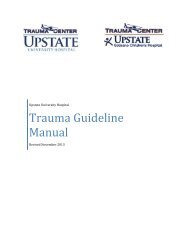Department of Pediatrics Biannual Report 2008-2009
Department of Pediatrics Biannual Report 2008-2009
Department of Pediatrics Biannual Report 2008-2009
You also want an ePaper? Increase the reach of your titles
YUMPU automatically turns print PDFs into web optimized ePapers that Google loves.
Bi-Annual <strong>Report</strong> • 31<br />
NEPHROLOGY<br />
FACULTY<br />
James Listman, MD, Assistant Pr<strong>of</strong>essor <strong>of</strong> <strong>Pediatrics</strong><br />
Scott Schurman, MD, Associate Pr<strong>of</strong>essor <strong>of</strong> <strong>Pediatrics</strong>,<br />
Section Head<br />
Thomas Welch, MD, Pr<strong>of</strong>essor <strong>of</strong> <strong>Pediatrics</strong>, Chairman,<br />
<strong>Department</strong> <strong>of</strong> <strong>Pediatrics</strong><br />
AFFILIATED CLINICAL STAFF<br />
Susan Sheffield, PNP, Nurse Practitioner and Coordinator<br />
Voiding Improvement Program<br />
Vickie Keeler, RN, BSN, MA<br />
AFFILIATED RESEARCH STAFF<br />
Lisa W. Blystone, MS, Instructional Support Specialist<br />
JoAnne E. Race, MS, Instructional Support Specialist<br />
CLINICAL OVERVIEW<br />
The Section <strong>of</strong> Nephrology provides inpatient<br />
consultation and acute dialysis care, including peritoneal<br />
dialysis, hemodialysis, and hem<strong>of</strong>iltration at the Upstate<br />
Golisano Children’s Hospital. Outpatient dialysis care,<br />
both peritoneal dialysis and hemodialysis, is provided<br />
at the University Dialysis Center in Syracuse. Other<br />
outpatient services are provided at our primary site in<br />
Syracuse, 725 Irving Ave., Suite 401, and satellite facilities<br />
in Watertown (Dr. Listman), Utica (Dr. Schurman), and<br />
Binghamton (Dr. Welch).<br />
The section evaluates and treats infants, children, and<br />
adolescents with the full spectrum <strong>of</strong> disorders <strong>of</strong> the<br />
urinary tract. This activity includes bread and butter<br />
nephrology, disorders such as nephrotic syndrome,<br />
glomerulonephritis, and all stages <strong>of</strong> chronic renal<br />
insufficiency. However, the section’s activity has few<br />
limits. We have an established expertise in the diagnosis<br />
and treatment <strong>of</strong> children with hypertension, including<br />
24 hour ambulatory blood pressure monitoring. We<br />
care for patients with mineral metabolism disorders<br />
and metabolic bone disease, including inherited and<br />
acquired forms <strong>of</strong> rickets, osteogenesis imperfecta, and<br />
osteoporosis. Metabolic evaluations <strong>of</strong> children with<br />
urolithiasis are performed, stressing dietary measures<br />
that can minimize risk <strong>of</strong> recurrence.<br />
The section provides coordinated care to infants and<br />
children with simple and complex urologic abnormalities,<br />
including prenatal visits. Patients with congenital or<br />
other hydronephrosis and vesicoureteral reflux are<br />
evaluated and followed. When necessary, urologic<br />
intervention is accessed.<br />
In addition, the section has attempted to address the<br />
growing number <strong>of</strong> children with voiding dysfunction,<br />
particularly children with associated daytime urinary<br />
urgency/incontinence and recurrent urinary tract<br />
infections. This effort, the “Voiding Improvement<br />
Program” (VIP) is coordinated by our pediatric nurse<br />
practitioner and nephrology nurse specialist, Susan<br />
Sheffield and Vickie Keeler. A multimodal approach to<br />
treatment is employed, including dietary, behavioral<br />
modification, and medication therapy.<br />
RESEARCH HIGHLIGHTS<br />
Role <strong>of</strong> Local Complement Synthesis in the<br />
Kidney<br />
Dr. Welch’s laboratory has continued its study <strong>of</strong><br />
novel roles for the human complement system in<br />
progressive renal disease. The role <strong>of</strong> activation and<br />
deposition <strong>of</strong> serum complement in the glomerulus<br />
as a major mediator <strong>of</strong> glomerulonephritis has long<br />
been established. We were the first laboratory to<br />
demonstrate that the human kidney itself could be a<br />
source <strong>of</strong> a number <strong>of</strong> complement components and<br />
that activation <strong>of</strong> these components in the peritubular<br />
interstitium was a major mediator <strong>of</strong> progressive renal<br />
damage.<br />
Over the past few years, we have developed a murine<br />
model <strong>of</strong> chronic immune complex glomerulonephritis<br />
and have used animals lacking various complement<br />
components as a mechanism for dissecting the specific<br />
role <strong>of</strong> complement in this process. We have further<br />
demonstrated that expression <strong>of</strong> the third component<br />
<strong>of</strong> complement, C3, is differentially regulated in the<br />
kidney and the liver. This has opened the possibility<br />
<strong>of</strong> specifically targeting renal complement expression<br />
without interfering with the important role <strong>of</strong> the<br />
complement cascade in the systemic immune response.<br />
We are now using the technique <strong>of</strong> gene expression<br />
analysis through microarray in order to examine<br />
differences in gene expression pr<strong>of</strong>iles between wild<br />
type animals and those lacking specific complement<br />
components. This is permitting us to understand<br />
the downstream molecular mechanisms by which<br />
peritubular complement activation induces renal<br />
damage.<br />
Finally, we have very recently been investigating ways in<br />
which progressive interstitial scarring can be attenuated.<br />
We have now shown in our murine model that<br />
angiotensin converting enzymes (ACE) inhibitors have a<br />
very important effect in attenuating interstitial injury in<br />
this model. Examining this effect in various complement<br />
deficient animals suggests preliminarily that this effect is<br />
mediated by a non-complement-dependent mechanism.<br />
Further examination <strong>of</strong> microarray data will allow us to<br />
explore more deeply the interplay between the many<br />
inflammatory cascades participating in renal damage.<br />
The ultimate goal <strong>of</strong> this would be to identify important<br />
pathways to target pharmacologically.

















